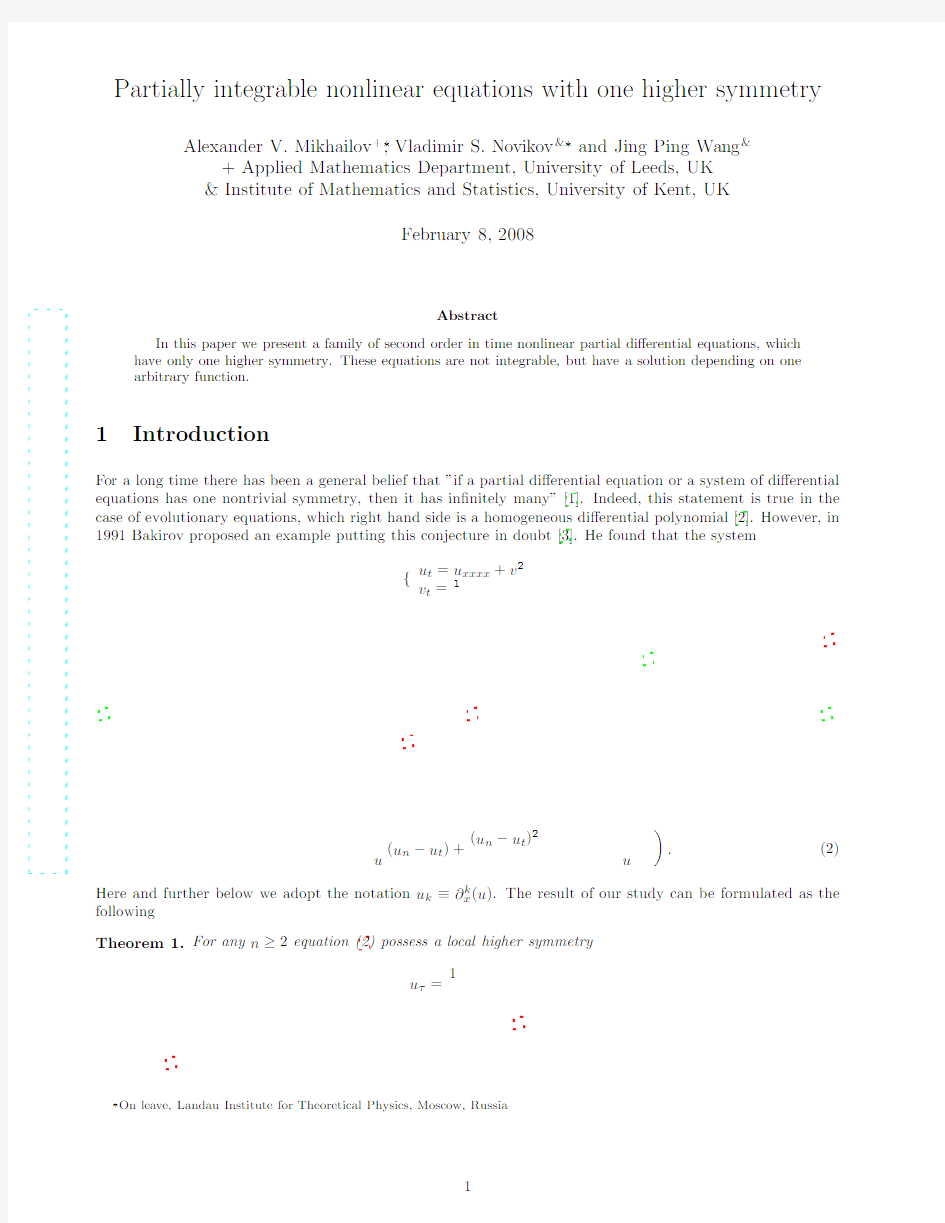Partially integrable nonlinear equations with one higher symmetry


a r X
i
v
:n
l
i
n
/
0601047v 1 [n l i n .S I ] 22 J a n 2006
Partially integrable nonlinear equations with one higher symmetry
Alexander V.Mikhailov +?,Vladimir S.Novikov &?and Jing Ping Wang &
+Applied Mathematics Department,University of Leeds,UK &Institute of Mathematics and Statistics,University of Kent,UK
February 8,2008
Abstract
In this paper we present a family of second order in time nonlinear partial di?erential equations,which have only one higher symmetry.These equations are not integrable,but have a solution depending on one arbitrary function.
1Introduction
For a long time there has been a general belief that ”if a partial di?erential equation or a system of di?erential equations has one nontrivial symmetry,then it has in?nitely many”[1].Indeed,this statement is true in the case of evolutionary equations,which right hand side is a homogeneous di?erential polynomial [2].However,in 1991Bakirov proposed an example putting this conjecture in doubt [3].He found that the system
{
u t =u xxxx +v 2v t =1
u
(u n ?u t )+
(u n ?u t )2
u
.(2)
Here and further below we adopt the notation u k ≡?k
x (u ).The result of our study can be formulated as the following
Theorem 1.For any n ≥2equation (2)possess a local higher symmetry
u τ=
1
?On
leave,Landau Institute for Theoretical Physics,Moscow,Russia
1
2Proof of the Theorem and discussion
There are many equivalent de?nitions of in?nitesimal local higher symmetries for partial di?erential equa-tions(see for instance[7]).In this paper we adopt the following de?nition.A partial di?erential equation uτ=G(u m,u m?1,...,u,u s,t,u s?1,t,...,u t)generates a local symmetry of equation(2)if it is compatible with equation(2)[8].A symmetry is called a higher symmetry of equation(2)if m>1or s>1.
Surprisingly enough equation(2)and its symmetry(3)can be rewritten in a very compact form
z t=z n?z2,(4)
uτ=z,(5) where
z=
1
u (u n?v)+
(u n?v)2
u ≡H[u,v].
Equation(3)is a symmetry of(2)if and only if system(7)is compatible with
uτ=
1
u
(u n?v) =?n x u n?v u2,
where D t stands for the operator of total di?erentiation with respect to t according to(7).Calculating the cross derivatives and expressing the results in terms of variable z(6)we obtain:
u tτ=vτ=z n?z2,
uτt=z t=z n?z2
and hence u tτ=uτt.Analogously
v tτ=?n x(z n?z2)?2z(z n?z2)?u?τ(z n?z2)?vzτ,
vτt=?n x(z n?z2)?2z(z n?z2).
It is easy to verify that zτ=0and therefore v tτ=vτt and hence(3)is the symmetry of equation(2).
Let us prove that symmetry(3)is the only local higher symmetry of equation(2).In our proof we shall use elements of the Perturbative Symmetry Approach in the symbolic representation[2,9].
Function H[u,v]in the right hand side of the system(7)can be rewritten in the form
H[u,v]=?u2n+2u n,t+
n
i=1f i(u)P i[u,v],(9)
where f i(u)=1
Equation(2)is a homogeneous equation,therefore polynomials P i are homogeneous polynomials of the weight
2n,i.e.W(P i)=2nP i,where
W=
∞
k=1ku k??v k.
Function H[u,v]can be treated as a di?erential polynomial in v and derivatives of u,v with coe?cients being functions of u only.The symbolic representation of such polynomials have been de?ned and studied in[10] To prove the second statement of the theorem we will need only a few?rst terms of the function H[u,v](9):
H[u,v]=?u2n+2v n+
+f1(u) ?n x(uu n?uv)?uu2n+u2n+uv n?3u n v+2v2 +R[u,v], where R[u,v]= i≥2f i(u)P i[u,v].Then in the symbolic representation system(7)can be rewritten as u t=?v,(11)
v t=??u k2n1+2?v q n1+f1(u)? ?u2a1(k1,k2)+?u?v a2(k1,q1)+2?v2) +?R[u,v],
where
a1(k1,k2)=
1
u
.
Let m=n.From the compatibility conditions of(11)and(12)it follows that
A3(q1,q2;u)=1
q n1+q n2?(q1+q2)n
.
Polynomial q n1+q n2?(q1+q2)n does not divide q m?n
1+q m?n
2
?2(q1+q2)m?n if m=n and therefore A3(q1,q2;u)
does not represent a symbol of a di?erential polynomial with u-depended coe?cients.It implies that g2(u)=0. Having g2(u)=0we?nd(from the compatibility conditions)that
A2(k1,q1;u)=f1(u)g1(u)
k m1+q m1?(k1+q1)m
For s>1the polynomial K s(x,y)=x s+y s?(x+y)s can be factorized as
K s(x,y)=xyT s(x,y),T s(0,y)=0(13) Hence
T m(k1,q1)
A2(k1,q1;u)=f1(u)g1(u)
